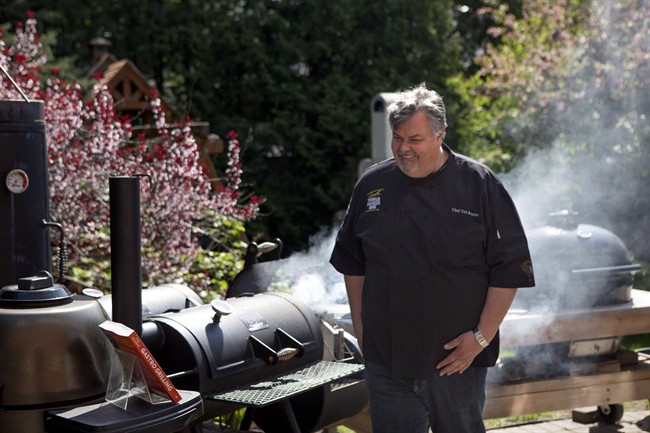TORONTO — Barbecue expert Ted Reader, who has more than 50 different types of grills, waxes eloquent when explaining his love for cooking with charcoal rather than gas.

“A gas grill gives you instantaneous heat. Charcoal gives you love,” the chef says from his Toronto backyard.
“You get that natural smoke coming off the charcoal. You get the heat of the fire. You get incredible temperature for searing, yet you can have it lasting a long period of time and give you that low and slow (heat) for barbecue.”
Charcoal barbecues are enjoying a resurgence with consumers who want to expand their barbecuing skills by playing with fire, says Naz Cavallaro, resident chef for the Canadian grill maker Broil King.
“Charcoal has gone crazy over the past four years. More and more people are getting into the charcoal way of doing things,” Cavallaro says.
But both experts say there are reasons to choose a gas grill and pros and cons for each type of cooking fuel.
Gas grills
A consistent temperature is easier to maintain with gas, either natural or propane, and many homeowners opt to install a natural gas line so it’s “always there,” says Cavallaro.
“You don’t have to worry about going and filling tanks, putting tanks in your car, putting yourself in an unsafe environment,” he says.
With propane, a tank can run out during grilling. And it’s not as efficient in winter because the gas doesn’t burn off properly when it’s too cold, Cavallaro adds.
On the other hand, a three-metre hose for a natural gas hookup prohibits much relocation, whereas a propane-fuelled barbecue can be moved around the yard.
When transporting a propane tank never lie it on its side or put it in the back seat of a vehicle.
Cavallaro finds standing a tank in a plastic milk carton works well to keep it in place.
READ MORE: BBQ safety tips and trends 2015
When installing a refilled propane tank he advises doing a simple leak test. Using a clean paint or basting brush, apply a mixture of half soap and water on the hose and tank connections. Slowly turn on the tank. If bubbles form, there’s a leak.
Charcoal grills
When it comes to charcoal grills, many swear by the smoky taste they offer — but patience is required.
“You learn to read the fire and understand what wind direction’s happening, what the humidity’s doing,” says Reader, who teaches in the food and technology program at Niagara College and develops products for grocery and restaurant chains.
“If it’s dead air out there, there might not be enough oxygen in the air. If it’s a high humid day with no wind to actually fuel your fire you won’t get as hot a burn.”
Lighting charcoal isn’t difficult but isn’t as quick as gas.
There are compressed paper cubes, electrical lighters and electronic hair dryer-type blowers available to start a charcoal grill. Reader likes the ease of using a charcoal chimney.
“You fill this tube with charcoal, put crumpled newspaper underneath, light the paper, it lights the charcoal. When it’s burning, dump it into your kettle and start cooking.”
Never use lighter fluid, which imparts an unpleasant flavour to charcoal and food.
READ MORE: Barbecue food safety guide: Keep hot foods hot and cold foods cold
There are many styles of charcoal grills, ranging from kettles and vertical barrel cookers to egg-shaped kamados that are ceramic and hold the temperature well.
“It doesn’t matter how cold the days are outside. I’ve been able to fire (a ceramic charcoal grill) and maintain temperature for hours and hours and hours outdoors,” says Reader.
“It offers consistency; you can grill hot and fast and you can smoke low and slow. And really, if I was going to invest I would invest in the best and I would look for a kamado cooker. I would put that in your backyard and learn how to use it. You won’t be needing to buy another grill or smoker for years. And I’m talking 10 years plus.”
No matter what type of grill you choose, both men advise reading the manual to get the most out of your appliance.


Comments